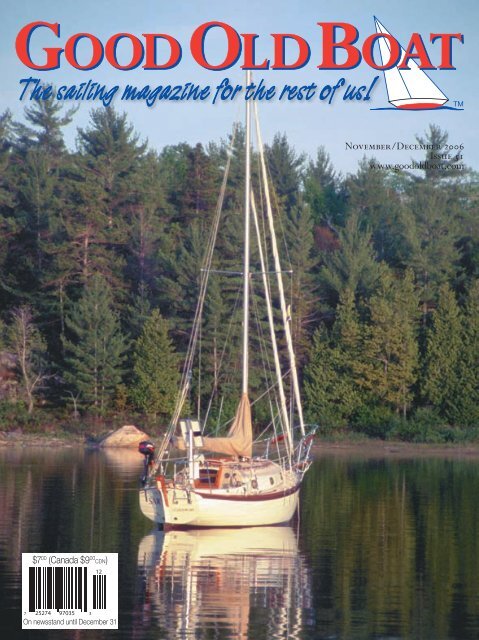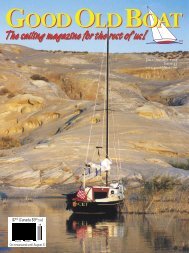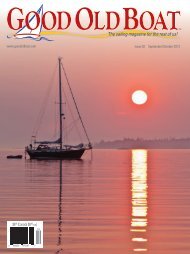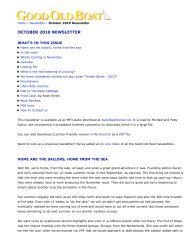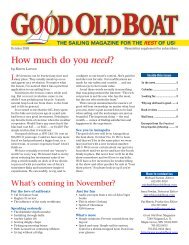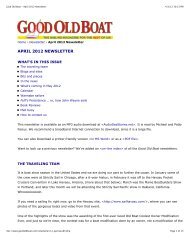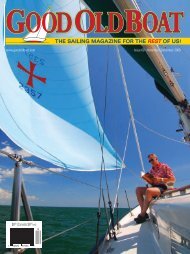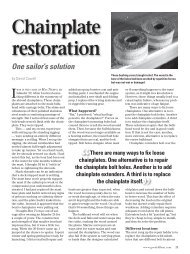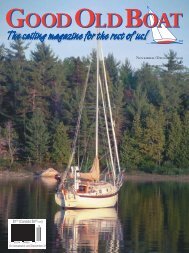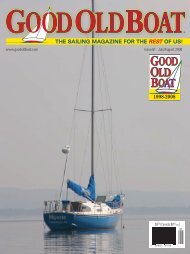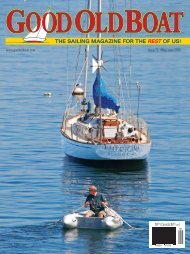The sailing magazine for the rest of us! - Good Old Boat Magazine
The sailing magazine for the rest of us! - Good Old Boat Magazine
The sailing magazine for the rest of us! - Good Old Boat Magazine
Create successful ePaper yourself
Turn your PDF publications into a flip-book with our unique Google optimized e-Paper software.
<strong>The</strong> <strong>sailing</strong> <strong>magazine</strong> <strong>for</strong> <strong>the</strong> <strong>rest</strong> <strong>of</strong> <strong>us</strong>!<br />
November/December 2006<br />
Issue 51<br />
www.goodoldboat.com<br />
$7 00 (Canada $9 00 CDN)<br />
12<br />
7 25274 97035 3<br />
On newsstand until December 31
Refit<br />
THE NEW OLD BOAT AT THE MARINA<br />
caught my eye. <strong>Boat</strong>s like that<br />
always do. Wow! A real cruiser.<br />
A 1960s boat. A Triton? An Alberg 30?<br />
Heavy-duty dodger, windvane on <strong>the</strong><br />
transom, mounts <strong>for</strong> storm boards<br />
on <strong>the</strong> ports, big CQR in a bow roller,<br />
and ano<strong>the</strong>r hanging on <strong>the</strong> p<strong>us</strong>hpit.<br />
Everything about her said she’d been<br />
somewhere and done something.<br />
She looked out <strong>of</strong> place, tucked into<br />
<strong>the</strong> crowd <strong>of</strong> weekend toys and dock<br />
potatoes. Her registration numbers<br />
said Cali<strong>for</strong>nia. Since we’re in North<br />
Carolina, that was a start.<br />
I recalled my next-door neighbor,<br />
Dave Ha<strong>us</strong>e, telling me, after finding<br />
out I sailed, that a co-worker <strong>of</strong> his<br />
had sailed his boat from Cali<strong>for</strong>nia<br />
through <strong>the</strong> Caribbean and up <strong>the</strong><br />
Intracoastal Waterway to Wilmington.<br />
A couple <strong>of</strong> email messages established<br />
<strong>the</strong> match — <strong>the</strong> boat was<br />
indeed a Pearson Triton. Be<strong>for</strong>e any<br />
time went by, I was a guest crew <strong>for</strong> a<br />
summer evening sail with her owner,<br />
Jack James, along with Dave and a guy<br />
who taught in <strong>the</strong> same department<br />
as I did and whose wife worked with<br />
Jack. That was four years ago.<br />
Ariadne’s<br />
This well-traveled<br />
Since <strong>the</strong>n, Dave has moved away,<br />
but Jack and his wife, Beth, and <strong>the</strong><br />
o<strong>the</strong>r guy, Tom Massey, along with<br />
his wife, Meg, have become our close<br />
friends. I’ve spent many an evening and<br />
weekend afternoon <strong>sailing</strong> Ariadne.<br />
She is <strong>the</strong> boat that showed me in real<br />
life what I’d only seen in books and<br />
<strong>magazine</strong>s — how a small long-distance<br />
liveaboard cruiser really works.<br />
<strong>The</strong> Triton is in many ways <strong>the</strong> Elvis<br />
<strong>of</strong> fiberglass sailboats and, as such,<br />
her history’s been recounted plenty <strong>of</strong><br />
times already — Sailboat Hall <strong>of</strong> Fame<br />
and <strong>the</strong> first really successful production<br />
fiberglass racer/cruiser. <strong>The</strong><br />
Triton, launched in 1959, put Pearson<br />
Yachts on <strong>the</strong> road to becoming <strong>the</strong><br />
world’s biggest sailboat builder. More<br />
than 700 Tritons were built. Dan Spurr<br />
once said it was probably <strong>the</strong> cheapest,<br />
smallest true bluewater-cruisingcapable<br />
boat (properly modified and<br />
equipped, <strong>of</strong> course) out <strong>the</strong>re. She’s<br />
a proven circumnavigator and is still<br />
raced as a one-design.<br />
Bullet-pro<strong>of</strong> hull<br />
Cruising traditionalists praise her<br />
modified full keel, bullet-pro<strong>of</strong> hull,<br />
barn-door rudder, and low freeboard.<br />
You don’t have to be Ted Brewer or sail<br />
this boat halfway around <strong>the</strong> world<br />
to appreciate her qualities; she’s dry<br />
despite her low freeboard, she sails like<br />
nobody’s b<strong>us</strong>iness, and she rides like<br />
a Cadillac — no mean set <strong>of</strong> feats <strong>for</strong> a<br />
boat j<strong>us</strong>t over 20 feet on <strong>the</strong> waterline.<br />
But if you want to tackle what Jack<br />
did, and turn a tired stock Triton into<br />
a seaworthy liveaboard cruiser, you’ve<br />
got your work cut out <strong>for</strong> you. Scan<br />
<strong>the</strong> big online boat listings, and you’ll<br />
rarely find a fully <strong>rest</strong>ored, tricked-out<br />
34 GOOD OLD BOAT November/December 2006
adventures<br />
Triton served as home <strong>for</strong> two<br />
<strong>for</strong> seven years<br />
by Phillip Reid<br />
Ariadne, far left, <strong>of</strong>f Portobelo,<br />
a heavily <strong>for</strong>tified outpost <strong>of</strong> <strong>the</strong><br />
16th century Spanish colonial empire.<br />
Jack on Ariadne in Cali<strong>for</strong>nia in <strong>the</strong> early<br />
1990s, far left. Beth, in Cuna mode, goes<br />
native in <strong>the</strong> San Blas islands, at right.<br />
like <strong>the</strong> ones on World War I fighter<br />
planes. If he couldn’t make it or salvage<br />
it, <strong>the</strong>re was Minney’s Yacht<br />
Surpl<strong>us</strong>. Some <strong>of</strong> Ariadne’s blocks<br />
and hardware came from a sunken<br />
wreck that Jack and a friend dove on<br />
in Mexico be<strong>for</strong>e <strong>the</strong>y were chased <strong>of</strong>f<br />
by <strong>the</strong> Mexican coast guard.<br />
He needed plenty <strong>of</strong> stuff. <strong>The</strong><br />
builder’s definition <strong>of</strong> “basic” in 1963<br />
is what we would call “not done yet”<br />
today, and while Jack knows little<br />
about her past, he does know she was<br />
already a veteran <strong>of</strong> Baja cruises and<br />
showing her age and mileage when he<br />
got her. He needed a full set <strong>of</strong> stanchions,<br />
lifelines, a pulpit and p<strong>us</strong>hpit,<br />
and an interior that didn’t have raw<br />
fiberglass surfaces. One cool thing he<br />
did get from <strong>the</strong> previo<strong>us</strong> owner was<br />
a homemade windvane self-steering<br />
system — <strong>the</strong> type <strong>of</strong> auxiliary rudder<br />
with a trim tab. It still works.<br />
Tritons have deck-stepped masts<br />
supported by an oak deck beam j<strong>us</strong>t in<br />
front <strong>of</strong> <strong>the</strong> break in <strong>the</strong> split-level cabin<br />
trunk. Ariadne’s was cracked when<br />
Jack came along — a common problem<br />
on hard-sailed aging Tritons — and<br />
he replaced it with a steel I-beam. He<br />
Triton <strong>for</strong> sale. What you will find are<br />
major projects going cheap. <strong>The</strong>re’s<br />
a world <strong>of</strong> difference between what<br />
<strong>the</strong> original owner got from Pearson<br />
in 1963 and what Ariadne is now, 43<br />
years later.<br />
Jack was a teenager when his fa<strong>the</strong>r<br />
bought his first sailboat — a Pearson<br />
Electra — so he got familiar with <strong>the</strong><br />
boatyard early in life. After <strong>the</strong> Electra,<br />
Jack Sr. bought a 35-foot wooden<br />
boat, and Jack learned <strong>the</strong> ins and outs<br />
<strong>of</strong> marine woodwork while helping to<br />
<strong>rest</strong>ore her. When he was 19, Jack and<br />
his fa<strong>the</strong>r sailed her from Cali<strong>for</strong>nia<br />
to Hawaii in March . . . a little early in<br />
<strong>the</strong> season. Jack says he was soaking<br />
wet <strong>for</strong> three straight weeks. Several<br />
years later he crewed on a 40-footer<br />
<strong>for</strong> a whale research expedition down<br />
<strong>the</strong> Baja coast. After living aboard a<br />
smaller boat <strong>for</strong> a while after college,<br />
Jack bought Ariadne in 1985, in sou<strong>the</strong>rn<br />
Cali<strong>for</strong>nia, even though she’s an<br />
East Coast Triton. He paid $10,000 <strong>for</strong><br />
her. He thought that was a great deal<br />
at <strong>the</strong> time. (Her original price was<br />
$9,700.) <strong>The</strong>n <strong>the</strong> bottom fell out <strong>of</strong> <strong>the</strong><br />
sailboat market.<br />
DIY paradise<br />
Jack was living in Los Angeles, which<br />
was a do-it-yourself sailor’s paradise.<br />
All <strong>the</strong> production builders in and<br />
around Costa Mesa had spawned a<br />
thriving sailboat-parts economy. Jack<br />
wandered through scrap yards and<br />
found stainless steel to make his anchor<br />
roller, beefed-up mast tabernacle,<br />
and storm-shutters.<br />
His two 40-watt solar panels were<br />
NASA surpl<strong>us</strong>, and he made his own<br />
wind generator which hangs from <strong>the</strong><br />
backstay and has a wooden propeller<br />
www.goodoldboat.com 35
Refit<br />
Without putting too fine a point on it, galleys were not <strong>the</strong> strong suit <strong>of</strong> <strong>the</strong> Tritons.<br />
Jack added a stove and vital cooking space by installing a Luke stove which folds<br />
up and out <strong>of</strong> <strong>the</strong> way when not in <strong>us</strong>e, above and far left. <strong>The</strong> drop-down table,<br />
center left, and counter space, below left. Notice <strong>the</strong> fine woodwork throughout.<br />
Jack is a capable finish carpenter.<br />
added a second set <strong>of</strong> lower shrouds to<br />
stop mast pumping. However, he says<br />
if <strong>the</strong> rig is stout, and <strong>the</strong> mast doesn’t<br />
pump, leave it alone.<br />
Rotten core<br />
Most <strong>of</strong> <strong>the</strong> deck core on one side,<br />
<strong>for</strong>ward <strong>of</strong> amidships, was rotten.<br />
Jack drilled six million tiny holes<br />
in <strong>the</strong> outer skin, poured acetone in<br />
<strong>the</strong>m, and squeegeed epoxy into <strong>the</strong>m.<br />
No problems since. When he went to<br />
a boatyard parts counter and asked<br />
<strong>for</strong> non-skid paint additive and <strong>the</strong>y<br />
tried to sell him a can <strong>of</strong> sand <strong>for</strong><br />
$13, he found some cr<strong>us</strong>hed walnut<br />
shells (plentiful in Cali<strong>for</strong>nia) and<br />
<strong>us</strong>ed those instead. Concerned about<br />
flex in <strong>the</strong> uncored, thin sterndeck,<br />
he glassed-in wood rein<strong>for</strong>cements<br />
underneath it and made a watertight,<br />
beefy door <strong>for</strong> <strong>the</strong> stern lazarette.<br />
<strong>The</strong> original Triton rudder was<br />
mahogany. Ariadne’s wasn’t in good<br />
shape, so Jack made her an exact copy<br />
out <strong>of</strong> solid fiberglass. While he had <strong>the</strong><br />
engine out, he replaced <strong>the</strong> shaft log.<br />
As frugal as Jack is, he does have<br />
a weakness <strong>for</strong> teak. Ariadne is a<br />
teak showcase. Jack reckons he spent<br />
around $2,000 on teak 20 years ago.<br />
He’s a capable finish carpenter, and<br />
her hatches, sea hood, propane locker,<br />
coamings, and interior trim are works<br />
<strong>of</strong> art. He built <strong>the</strong> athwartships cockpit<br />
locker abaft <strong>the</strong> bridge deck. <strong>The</strong><br />
swing-down teak stovebox with <strong>the</strong><br />
flip-down front and gimbaled Luke<br />
stove is very well done. He was living<br />
aboard while he did <strong>the</strong> interior, and<br />
he made almost everything with a<br />
jigsaw on <strong>the</strong> dock and a bench sander<br />
he kept in <strong>the</strong> cockpit.<br />
Jack met Beth in 1987. A farm girl<br />
from New Hampshire finishing college<br />
in Cali<strong>for</strong>nia, she warned him be<strong>for</strong>e<br />
<strong>the</strong>ir first weekender to <strong>the</strong> Channel<br />
Islands that she got seasick, but that<br />
didn’t stop him. Beth was getting out<br />
<strong>of</strong> school and needed a job, and Jack<br />
encouraged her to work at West Marine,<br />
where <strong>the</strong>y proceeded to score<br />
gear — inverter, regulator, <strong>the</strong> Luke<br />
stove, and an early hand-held GPS<br />
— at <strong>the</strong> employee discount as <strong>the</strong>y<br />
got ready <strong>for</strong> <strong>the</strong> trip down south.<br />
Two luxuries<br />
Still, <strong>the</strong>y kept it simple. <strong>The</strong> two<br />
mechanical luxuries on Ariadne are<br />
a manual windlass (not a luxury on<br />
a larger boat, but counts as one on a<br />
28-footer with a chain/rope rode) and<br />
refrigeration (an Adler Barbour Cold<br />
Machine <strong>for</strong> which Jack added a third<br />
battery). Jack confirms what’s generally<br />
reported: <strong>the</strong> stock front-loading<br />
Triton icebox is poorly insulated. But<br />
he was pleased with <strong>the</strong> refrigerator<br />
as <strong>the</strong>y cruised <strong>the</strong> tropics and reports<br />
that <strong>the</strong> wind generator and solar panels<br />
were able to keep up with it.<br />
On <strong>the</strong>ir way down <strong>the</strong> Baja Peninsula,<br />
<strong>the</strong>re were enough windless<br />
36 GOOD OLD BOAT November/December 2006
days that <strong>the</strong>y found <strong>the</strong>mselves handsteering<br />
far more than <strong>the</strong>y wanted to,<br />
so when <strong>the</strong>y got to Nuevo Vallarta on<br />
<strong>the</strong> Mexican mainland, <strong>the</strong>y bought a<br />
<strong>us</strong>ed autopilot at a cruisers’ secondhand<br />
sale on <strong>the</strong> beach <strong>for</strong> $30. It<br />
worked. <strong>The</strong>ir “hand-held VHF,” which<br />
is <strong>the</strong> size <strong>of</strong> a World War II walkietalkie,<br />
cost $1. It works too. <strong>The</strong>ir<br />
inflatable dinghy, which <strong>the</strong>y finally<br />
replaced last year when it j<strong>us</strong>t couldn’t<br />
be patched anymore, was bought<br />
<strong>us</strong>ed, as was <strong>the</strong> outboard.<br />
But as inspiring as Jack’s improvements<br />
and upgrade list is, it should<br />
be noted that what wasn’t broken on<br />
Ariadne didn’t get fixed. <strong>The</strong> most<br />
valuable lesson I learned from Ariadne<br />
was not what I needed, but what<br />
I didn’t need on my own project boat.<br />
Her original, raw-water-cooled<br />
Atomic 4, which Jack pulled and had<br />
rebuilt in <strong>the</strong> ’80s, still starts every<br />
time and runs like a champ after 42<br />
years and some serio<strong>us</strong> cruising, all<br />
in salt water. (He’s religio<strong>us</strong> about<br />
fl<strong>us</strong>hing and tightening <strong>the</strong> grease<br />
cup on <strong>the</strong> water pump.) <strong>The</strong> original<br />
alternator lasted until last year, and<br />
<strong>the</strong> original starter still works. Her<br />
DC panel is original, as is much <strong>of</strong> her<br />
ho<strong>us</strong>e wiring, main battery switch,<br />
galley sink, icebox, ports, spars, and<br />
interior lights.<br />
Headed south<br />
Jack, a chemist, sold his one-man<br />
garage b<strong>us</strong>iness making orthodontic<br />
parts. With that as <strong>the</strong>ir kitty, he and<br />
Beth sailed Ariadne from San Diego<br />
in November 1993, heading down <strong>the</strong><br />
Baja Peninsula to <strong>the</strong> Mexican Pacific<br />
coast. <strong>The</strong>y explored Baja and Mexico,<br />
<strong>the</strong>n jumped to Costa Rica, where <strong>the</strong>y<br />
lingered <strong>for</strong> months.<br />
Moving on to Panama, <strong>the</strong>y<br />
knocked around <strong>the</strong> Pacific side <strong>for</strong> a<br />
month or so, did <strong>the</strong> Panama Canal,<br />
helped some o<strong>the</strong>r cruisers through<br />
<strong>The</strong>se days, Ariadne sails at Wrightsville Beach, above. Jack’s mighty road rig, top<br />
right. Jack’s hurricane strategy is simple: 1. load boat on trailer, 2. take boat far<br />
inland. Even while waiting contentedly in her slip in Wilmington, North Carolina,<br />
top left, Ariadne, appears to be ready and able to go anywhere at any time.<br />
www.goodoldboat.com 37
Refit<br />
<strong>the</strong> canal and, once on <strong>the</strong> Caribbean<br />
side, proceeded to fall in love with <strong>the</strong><br />
San Blas islands, which at <strong>the</strong> time<br />
weren’t well-known. Picture a tropical<br />
island paradise, <strong>the</strong>y say, and you’ve<br />
got <strong>the</strong> San Blas Islands.<br />
Ariadne’s V-berth is still graced<br />
with molas, colorful appliquéd panels<br />
made by <strong>the</strong> Cuna, <strong>the</strong> last indigeno<strong>us</strong><br />
A view from <strong>the</strong> mas<strong>the</strong>ad, when<br />
Ariadne was in <strong>the</strong> Caribbean, shows<br />
<strong>the</strong> beautiful waters Jack and Beth<br />
enjoyed not long ago.<br />
Caribbeans. Framed molas also hang<br />
in <strong>the</strong>ir log ho<strong>us</strong>e in <strong>the</strong> woods. <strong>The</strong>y<br />
found <strong>the</strong> Cuna fascinating, and <strong>the</strong><br />
Cuna were well-disposed toward<br />
Americans, whose government had<br />
once helped <strong>the</strong>m in <strong>the</strong>ir knockdown-drag-out<br />
fight <strong>for</strong> autonomy<br />
against <strong>the</strong> Panamanian government.<br />
Panama was finally <strong>for</strong>ced to recog-<br />
nize a treaty that set aside <strong>the</strong> San<br />
Blas islands as an autonomo<strong>us</strong> reservation<br />
<strong>for</strong> <strong>the</strong> Cuna. Jack and Beth<br />
never wanted to leave, but <strong>the</strong> Cuna,<br />
while friendly and hospitable, do not<br />
allow outsiders to swallow <strong>the</strong> anchor<br />
in <strong>the</strong>ir unique world.<br />
So <strong>the</strong>y sailed over to Cartagena<br />
and spent some time exploring coastal<br />
Colombia, went back to <strong>the</strong> San Blas,<br />
explored <strong>the</strong> Bay Islands <strong>of</strong> Honduras,<br />
and poked around Guatemala and<br />
Belize be<strong>for</strong>e heading up <strong>the</strong> Yucatán<br />
coast. From Isla Mujeres, two years<br />
after <strong>the</strong>y left San Diego, <strong>the</strong>y crossed<br />
<strong>the</strong> Gulf <strong>of</strong> Mexico to Florida. <strong>The</strong><br />
cruising kitty was nearly empty. <strong>The</strong>y<br />
made <strong>the</strong>ir way up <strong>the</strong> ICW all <strong>the</strong> way<br />
to New Bern, North Carolina, and <strong>the</strong>n<br />
to Wilmington <strong>for</strong> Jack to take a job<br />
with a pharmaceutical development<br />
company.<br />
C<strong>us</strong>tom trailer<br />
He and Beth bought a ho<strong>us</strong>e two<br />
years after <strong>the</strong>y got to North Carolina,<br />
and Ariadne was no longer <strong>the</strong><br />
Square Drive<br />
Silicon Bronze<br />
<strong>Boat</strong> Building<br />
Screws<br />
Traditional Cut Thread<br />
Silicon Bronze screws have<br />
a significant advantage over<br />
<strong>the</strong> more common rolled<br />
thread screws, as most boat<br />
builders know. <strong>The</strong> full body<br />
diameter shank helps create<br />
an important seal as <strong>the</strong><br />
wood swells. Combine that<br />
advantage with a Square<br />
Drive recess, and you have<br />
a boatbuilding screw that is both<br />
easy to drive and effective as well.<br />
We stock 35 sizes, from #6 x 1/2” to<br />
#14 x 3”, all in Square Drive!<br />
Write <strong>for</strong> FREE catalog!<br />
SQUARE DRIVE SCREWS<br />
PO Box 11169 • Dept GOB<br />
Lynchburg • VA • 24506-1169<br />
38 GOOD OLD BOAT November/December 2006
permanent home she’d been <strong>for</strong> seven<br />
years. Jack had a c<strong>us</strong>tom trailer made<br />
<strong>for</strong> her, bought a <strong>us</strong>ed dual rear wheel<br />
pickup (which toge<strong>the</strong>r cost far more<br />
than <strong>the</strong> boat), and hoped to <strong>us</strong>e that<br />
rig <strong>for</strong> short-term cruises much more<br />
than he actually has so far since he<br />
went back to <strong>the</strong> 9-to-5. He hauls <strong>the</strong><br />
boat <strong>for</strong> hurricanes and trucks her<br />
inland. He and Beth spent one hurricane<br />
living aboard on <strong>the</strong> trailer<br />
in a Wal-Mart parking lot, cozy and<br />
com<strong>for</strong>table and, most importantly,<br />
not worried about <strong>the</strong> boat. <strong>The</strong> only<br />
trailer<strong>sailing</strong> trip he’s had time <strong>for</strong><br />
so far has been to <strong>the</strong> Bahamas with<br />
his fa<strong>the</strong>r. <strong>The</strong>y trucked <strong>the</strong> boat to<br />
Florida to make <strong>the</strong> shortest possible<br />
Gulf Stream crossing.<br />
How does <strong>the</strong> Triton measure up as<br />
a liveaboard home <strong>for</strong> two? “It’s pretty<br />
cramped,” Jack says, “It’s about as<br />
small as you can really get and make<br />
it work.” (He’s 6 foot 2 inches and Beth<br />
is 5 foot 10 inches. <strong>The</strong>y hit <strong>the</strong>ir heads<br />
a lot.) But <strong>the</strong>y made it work <strong>for</strong> years.<br />
<strong>The</strong>y emphasize that making a small<br />
boat work as a home is much easier<br />
in <strong>the</strong> tropics and subtropics where<br />
you spend most <strong>of</strong> your time on deck<br />
and in <strong>the</strong> cockpit, which is why good<br />
canvas is so important. You don’t need<br />
insulation or artificial climate control;<br />
you can dive overboard to cool <strong>of</strong>f and<br />
clean up.<br />
When <strong>the</strong>y got to <strong>the</strong> East Coast,<br />
<strong>the</strong>y experienced <strong>the</strong>ir first real winter<br />
aboard. Condensation dripped <strong>of</strong>f<br />
<strong>the</strong> overhead, and Jack found himself<br />
improvising interior insulation out<br />
<strong>of</strong> <strong>the</strong> foam-cloth <strong>us</strong>ed on car overheads,<br />
with limited success and lots<br />
<strong>of</strong> mildew. <strong>The</strong> extra clo<strong>the</strong>s you need,<br />
blankets, stove fuel, being stuck below<br />
. . . cold wea<strong>the</strong>r completely changed<br />
<strong>the</strong> equation, <strong>the</strong>y say.<br />
waves were huge; <strong>the</strong>y filled <strong>the</strong> cockpit<br />
constantly, but <strong>the</strong>y rode through it.<br />
Jack’s not a fan <strong>of</strong> slow boats or <strong>of</strong><br />
unwea<strong>the</strong>rly hulls and rigs. “A cruising<br />
boat needs to be reasonably fast and<br />
able to beat <strong>of</strong>f a lee shore,” he says.<br />
When <strong>the</strong>y crossed <strong>the</strong> Gulf <strong>of</strong> Mexico<br />
to Florida <strong>the</strong>y found <strong>the</strong>mselves<br />
outrunning an unexpected hurricane.<br />
According to Jack, <strong>the</strong> first priority<br />
should be to get a good <strong>sailing</strong> boat.<br />
<strong>The</strong>n make that boat as livable as you<br />
can without compromising her <strong>sailing</strong><br />
per<strong>for</strong>mance more than you have to.<br />
Beth says she wouldn’t trade <strong>the</strong><br />
cruise <strong>for</strong> anything but wouldn’t want<br />
to do it again. She spent pretty much<br />
<strong>the</strong> entire time underway on seasickness<br />
drugs, and she hasn’t been <strong>sailing</strong><br />
on open water again since <strong>the</strong>ir return<br />
Ariadne ghosts along <strong>of</strong>f Wrightsville<br />
Beach on a beautiful fall day<br />
with un<strong>us</strong>ually light winds.<br />
to <strong>the</strong> U.S. She was ready to have a<br />
ho<strong>us</strong>e, a garden, and to settle down.<br />
Jack hopes to persuade her to do<br />
sheltered-water cruises on <strong>the</strong> East<br />
Coast, <strong>us</strong>ing <strong>the</strong> truck and trailer to<br />
minimize time in transit to intended<br />
cruising grounds. But <strong>for</strong> now Ariadne<br />
is a daysailer and overnighter<br />
(<strong>the</strong>y like to anchor out overnight<br />
once in a while in <strong>the</strong> sound behind<br />
Wrightsville Beach) — though she<br />
stands far apart from <strong>the</strong> crowd <strong>of</strong><br />
daysailers and overnighters around<br />
here. Her past life and all those tropical<br />
miles under her keel are written all<br />
over her. Her future as a cruising boat<br />
may be unclear, but one thing is certain:<br />
“I’ll die with this boat,” Jack says.<br />
After that, who knows where Ariadne<br />
will go and what she will do?<br />
Many fans<br />
When it comes to her per<strong>for</strong>mance at<br />
sea, Jack joins <strong>the</strong> chor<strong>us</strong> <strong>of</strong> <strong>the</strong> Triton’s<br />
many fans. “I’d tr<strong>us</strong>t <strong>the</strong> boat anywhere<br />
but in ice,” he says. (He’d only<br />
take a steel boat into ice.) During <strong>the</strong>ir<br />
travels, <strong>the</strong>y ran into one bad storm<br />
<strong>of</strong>f Colombia. <strong>The</strong>y set <strong>the</strong> windvane,<br />
went below, and lay down, popping up<br />
every so <strong>of</strong>ten to take a look around.<br />
Beth <strong>rest</strong>ed on <strong>the</strong> low settee berth;<br />
Jack made himself com<strong>for</strong>table on<br />
<strong>the</strong> cabin sole on some c<strong>us</strong>hions. <strong>The</strong><br />
<br />
<br />
<br />
<br />
<br />
<br />
<br />
www.goodoldboat.com 39


